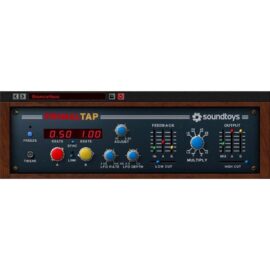What is delay?
Delay is an effects process that takes incoming signals and plays delayed copies to simulate the sound of echoes.
In the real world, an echo occurs in acoustic spaces where the reflecting surface is far enough away from the sound source and the listener to make the reflection sound like a distinct, separated repetition or "blanket" of the original sound. This can be heard, for example, when you shout something down a well.
Two identical sounds, when played in rapid succession with a delay between them of 1ms to 50ms, will appear as one interlaced sound to a listener. Any delay longer than this will start to sound more like a distinct echo.
Reverb, flangers og choruseffects are all delay-based effects where the delay parameters are adjusted or the signal is modulated to create different sound results compared to a straight delay effect.
This is how delay works
Delay effects are similar in function, although the form or technology varies between types of delays. The effect is achieved by recording or 'buffering' the signal and then playing back repeats of the signal at later times. Different types of delay effects will have differences in how the repeats or delay tails are modulated.
When is delay best used?
Short answer: Anywhere you want!
Delay, like most other things in music production and mixing, is something that doesn't necessarily have special rules around it. There are no fixed rules for delay effects. But there are plenty of good ideas.
With that said, there are some standard practices that are standard for good reasons. In most cases, it is best to insert delay as a send effect, in parallel with your dry signal, rather than as an insert effect in series. This gives you more control over the mix and opens up a world of processing possibilities as you can process your send channel separately to add modulation, distortion, EQ or the kompressio to your wet signal only.
Of course, there are times when you want to use delay as an insert effect, but this simply means that every plugin you insert after your delay will process your wet and dry signals together. Less control!
As for where to place delay in relation to other effects in your chain:
This depends on what you are trying to achieve. Again, no hard and fast rules. Delay usually works better before reverb because when you send reverb into a delay, you're delaying your reverb, which can get really messy really quickly.
Compressor before or after delay? Place it earlier and you affect the sound going into the delay. Place it after and you affect what comes out of the delay. So if you want to change the dynamics of the wet delay signal or the delay tail, place it after.
If you want the sound going into the delay to hit the delay more evenly, place your compressor before the delay. There's no reason not to do both if it works for you!
In fact, this is a good way to think about the order in any signal chain for your effects. Which signal do you want to affect and where? Do you want to process what goes into or comes out of your delay? Try one way and then the other. Listen for what works. Keep it and move on to the next one!
Basic delay effect parameters explained:
- Tempo or BPM:
Sets the tempo at which the delay device or plugin operates. You usually match the tempo of the DAW project, but this is not a rule.
- Tap tempo:
Many delay devices or plugins allow you to dial in the tempo using a pad controller or your mouse.
- Dry/Wet or Mix:
Sets the ratio of the dry original signal to the wet delayed signal. Set this to 100% wet and you will only hear the delay signal. Set it to 100% dry and you only hear the original signal.
- Delay Time:
This sets the time between the separate, distinct subsequent repetitions. - Feedback:
Controls how many repeats are played after the original sound. This allows you to set the length of your delay tail. Each delay is slightly lower in level until it falls into silence after the last delay.
A feedback setting of 100% means that each repeat will be as loud as the next and will continue to repeat until you lower the feedback setting. A 50% feedback means that each repetition will be half the level of the repetition before it until the repetitions fall silent.

Classic delay techniques:
Slap Back Delay: This technique goes way back in time! Popular in the 50s and 60s and often used on vocals and guitars.
Doubling Delay: Pretty much a slap-back delay with a shorter delay time and some processing of the wet signal.
Ping-Pong Delay: A dual delay effect that creates a call-and-response dynamic between the two repetitions of the delay.
Stereo Widening-Thickening Delay: Two similar signals, when played back, one from the left speaker and the other from the right, with a very short delay between them, will register as one sound to the listener.
Vocal Delay Techniques: There's no doubt that pop music today uses vocal delay effects a lot!
How to use delay like a pro when mixing:
The short and long of it:
- Short delay below 100ms tends to blend in and blur the edges of the original dry sound.
Keep track of your math:
Music is feeling, yes. But it becomes mathematics when we analyze and work with it.
Connect the dots:
Stabs and single hits can benefit from synchronized delays.
Create some groove:
Delay can be used in many ways to create groove in your tracks
Texture and Beds:
Delay effects with extreme feedback settings can be useful for creating beds, texture and other creative effects.
The use of delay effects in music production and mixing is an important part of the producer's skills. So make sure you learn all you can about it, and more importantly, use delay as much as possible to learn its uses and get better at choosing the right delay for the job. Enjoy.



